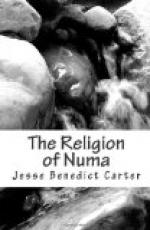Now that the old Roman gods had been changed into new-fangled Greek gods, and the old Roman priesthoods into modern political clubs, it is little wonder that the religion of the fathers ceased to satisfy their descendants. But while history shows that specific religious creeds have often proved mortal and subject to change and decay, the same history makes clear that the religious instinct is a constant factor in humanity; and we must not suppose for a moment that the religious need of the Roman community had ceased to exist, simply because the religion of the state had ceased to satisfy it. From the day when the Sibyl gave her first oracles to Rome on down to the time of Sulla, the desire for the sensational and the extraordinary in religion had been steadily growing. It had its birth in the idea that there was such a thing as a direct communion with the deity, and that the oracles were an immediate command from him. It was nourished by the sense of foreignness in the Greek ceremonies gradually introduced into the cult. It fed on the more sensational aspects of certain of the gods brought in: on the enthusiastic rites of Bacchus, on the miracle-working of Aesculapius, on the Stygian mystery of Dis and Proserpina. But its fulfilment was to come from the East, that inexhaustible fountain of religious energy. In the Magna Mater it recognised its own. This was the first undiluted Orientalism which came to Rome. But the state itself had received it, and had managed in some unaccountable way to put upon this outlandish Eastern cult the stamp of Rome’s nationality, that stamp which no nation ever successfully and permanently resisted; and thus the reception of the cult on the part of the state was not only a disgraceful thing, tending to degrade true religion and spread the contagion of Orientalism, but it also made those whose appetite had been aroused eager for other deities, whose cult would have the great additional charm of being unlicensed by the state, and hence savouring of unlawfulness.
Such a cult, long half-consciously desired, was at length found, when in B.C. 92 the Roman soldiery commanded by Sulla penetrated into the valley of Comana in Cappadocia. There was a whole community, a miniature state, devoted to the service of a goddess not unlike the Great Mother of Pessinus, but whose cult was more ecstatic, more orgiastic, than that of the Magna Mater, at least as Rome knew her. The king was the chief priest, and the citizens were priests and priestesses. The war with Mithradates brought the Roman army there again and also to another Comana in Pontus, where there was a branch of the Cappadocian cult. It was not the ignorant soldiery alone who were impressed by what they saw; their leader, Sulla, was fully as much affected, and on his return to Italy when the great crisis in his career, his march on Rome and his storming of the Eternal City, lay before him, it was the goddess of Comana who appeared to him in a dream




